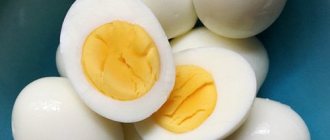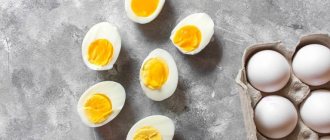KBJU: calorie content and composition
The calorie content and composition of eggs depends, first of all, on their size - plus, on the amount of oil used. On average, one large chicken egg weighs 50 g - and up to 7-10 g of fat is used to prepare scrambled eggs. This is why boiled eggs actually contain fewer calories than fried eggs.
// KBJU of one egg (weighing 50 g)²:
- calorie content - 72 kcal
- proteins - 6.3 g
- fats - 5 g
- carbohydrates - 0.4 g
The white of an egg accounts for about 17 kcal, the yolk - 55 kcal. Fats (including cholesterol) are found exclusively in the yolk.
Vitamins and minerals
The key vitamins in eggs are B vitamins - riboflavin (vitamin B2) and cobalamin (vitamin B12). They play an important role in the functioning of the body and maintaining cardiovascular health - especially when eliminating meat and other animal products from the diet.
Fat-soluble vitamins A, D and E are also beneficial - they are necessary for the functioning of the immune system, as well as for the health of skin, hair and nails.
// Vitamins in egg (50 g):
- riboflavin - 14% DV
- vitamin B12 - 11% of the norm
- pantothenic acid – 7%
- folic acid - 6%
- vitamin A - 5%
- vitamin B6 – 4%
- vitamin D - 4%
- vitamin E - 2%
***
Among the minerals contained in chicken eggs, selenium should be especially noted - it is responsible for dozens of biochemical reactions in the body, promotes the synthesis of thyroid hormones, and also enhances the effect of vitamin E and iodine.
// Minerals in egg (50 g):
- selenium - 23% daily value
- phosphorus - 10% of the norm
- iron - 5%
- zinc - 4%
- calcium - 3%
- copper - 3%
- sodium - 3%
- magnesium - 2%
***
Chicken eggs are a unique food product containing high-quality protein, vitamins and more than ten different minerals. Eating eggs benefits the body of children and adults, as they contain substances important for the functioning of the nervous system.
Scientific sources:
- Egg consumption and endothelial function, source
- Egg, whole, raw, fresh Nutrition Facts & Calories, source
- Soy lecithin Supplement – Science-based Review on Benefits, Dosage, Side Effects, source
Instead of a preface
Content:
- Instead of a preface
- Nutritional characteristics
- Cholesterol isn't so bad?..
- Benefits for humans
- Possible health risks
- Not all eggs are the same
- How to choose and store the product correctly
- What does the marking say?
- Use in cooking
- Use in home cosmetics
- Interesting facts about eggs
There is an assumption that this product entered the diet of ancient people long before the first chickens were domesticated. It will not be a mistake to say that it has been feeding man for several thousand years. Throughout this time, in many cultures, the egg has been a symbol of fertility, life and rebirth. In Christianity, eggs with colored shells symbolize Easter, and the ancient Egyptians believed that the gods created this product from the Sun and Moon. It is believed that the inhabitants of Southeast Asia or India were the first to consume eggs. Then they learned about them in Egypt, Greece and other countries of the ancient world.
In the 17th century The French's favorite delicacy was cocktails made from sour fruit juices and eggs. In the 19th century humanity came up with the idea of drying this product. This practice helped the military survive during World War II. And the familiar cardboard trays for eggs appeared only in 1911.
It is difficult to say in which country they first learned how to cook delicious eggs. However, the first gourmets could not help but notice that they quickly satisfy hunger, are easily digested by the body, and are also delicious.
What does the marking say?
Perhaps everyone knows that eggs from stores always contain a stamp. In addition to the expiration date, it tells a lot of interesting things about the product.
In the CIS, chicken eggs are usually divided into “C” and “D”. This designates the category of products - table or dietary. It should be understood that both options are the same chicken eggs (perhaps even from the same laying hen), the only difference is freshness. Dietary ones are very fresh, almost straight from the nest. Their exceptional freshness is maintained for 7 days; after this period, the product becomes “table” and can be stored in the refrigerator for up to 90 days, and in room conditions - no more than 25 days.
Chicken eggs are also classified by weight. The higher the grade, the more the specimen weighs. First-class eggs should not weigh less than 70 g, and representatives of the 7th grade may not reach up to 45 g. There is also a top grade - eggs weighing more than 75 g, but such giants are very rare.
A slightly different classification is followed in European countries. There, the A-Extra class egg is the freshest product (analogous to our dietary eggs). And then, as they “age”, the eggs move from class to class, from A to C.
But the color of the shell means absolutely nothing. More precisely, he only says that white eggs were laid by white chickens, yellow eggs by dark birds. However, this indicator does not in any way affect the nutritional characteristics and quality of the product itself [14].
Possible health risks
Some researchers advise people with diabetes, high cholesterol, or hypertension to use this product with caution. Canadian cardiologists say that people with diabetes who regularly consume eggs are more likely to develop cardiac diseases. Such people are advised to eat only proteins.
Scientists from Harvard also had their say. They warn against combining eggs with cheese, ham, bacon, white bread and other high-calorie foods. It is also not recommended to consume raw eggs, since raw egg whites interfere with the absorption of biotin, a substance important for maintaining healthy metabolic processes. In addition, there is a high probability of infection with salmonella [11].
People with allergies will have to avoid this product. The reaction to the product is manifested by skin rashes, difficulty breathing, stomach pain, and in rare cases, anaphylactic shock.
Cholesterol isn't so bad?..
At the turn of the twentieth century, scientist Nikolai Anichkov conducted an experiment on rabbits. He introduced pure cholesterol into the animals' diet. As a result, their arteries deteriorated, and the results of the experiment led to the conclusion that cholesterol causes heart disease. Later, in the 1950s, Ancel Keys published the results of a different study, concluding that people who consumed animal fats were more likely to develop heart disease. Although it is worth noting that today such conclusions raise doubts among scientists. So, both of these scientific experiments created a fear of cholesterol and animal fats. And modern international associations of cardiologists recommend consuming less than 300 mg of cholesterol per day. The yolk of a small chicken egg contains approximately 45% of the recommended amount. And this, you see, is a lot.
The results of one of the first scientific experiments to determine the effect of a chicken egg on cholesterol levels in the bloodstream were disappointing. Researchers from Harvard announced that it is enough to eat this product every day for 3 weeks and get from 97 to 418 mg of cholesterol per day so that the level of low-density lipoproteins (the so-called bad cholesterol) increases by 12 percent. The Brazilians conducted a similar experiment in 2006. The results are also disappointing: if you eat 3 eggs a day for a long time, your blood cholesterol will increase by almost 30 percent.
After similar results, scientists were quite surprised when they analyzed the results of another experiment conducted in 2008. This time, 19 study participants consumed 1 egg daily for a month. None of them had any changes in their blood count after this time. After this, scientists began to say that the relationship between cholesterol and egg yolks is not an indisputable fact [4].
Then, in different countries, researchers conducted many more experiments that gave very different results. Thus, a new assumption appeared: 1 chicken egg per day does not increase the level of bad cholesterol [5].
Moreover, already in 2013, a new revolutionary statement from scientists appeared: chicken eggs actually increase the concentration of cholesterol, but only “good” cholesterol (high-density lipoproteins), and this already helps to replenish the reserves of lutein and zeaxanthin, which are beneficial for the eyes.
Use in home cosmetics
Both components of the product – proteins and yolks – are used as natural cosmetics. Egg whites contain a lot of vitamin A and collagen, which makes them effective in the fight against scars, burns, wrinkles, and acne. Egg yolk is an excellent way to nourish and stimulate hair growth.
Face masks
Recipe 1. It is difficult to find an easier, but equally effective recipe than this one. Simply beat an egg and apply the mixture to your face. Keep it for half an hour. A whole egg is suitable for normal skin, only the white for oily skin, and the yolk for dry skin.
Recipe 2. Mix egg white, half a tablespoon of starch (preferably corn starch), a couple of drops of lavender essential oil. Keep for about 30 minutes.
Recipe 3. Mix the beaten whites of 2 eggs and 2 tablespoons of yogurt (no fillers). To relieve irritation on the face, leave it on for about half an hour.
Recipe 4. Mash 1 ripe avocado, to which add 50 ml of honey and 1 egg yolk. Leave for about 15 minutes, then rinse and apply moisturizer.
By the way, this same mixture is suitable as a mask for hair and scalp.
Hair masks
Recipe 1. Mix 2 eggs with 2 tablespoons of olive oil and 1 tablespoon of honey. Apply to the entire length of hair, wrap with plastic wrap and a terry towel. Keep for at least an hour.
Recipe 2. A mask of 2 yolks and 1 tablespoon of mayonnaise will make it easier to comb curly hair. This product is also suitable for dry and brittle curls.
Taking during a diet
This product is used for weight loss or during a diet. This is possible for the following reasons:
- a low-calorie product that makes it possible to prepare a dietary dish that does not increase weight;
- low price;
- preparing a large number of dishes that are eaten for breakfast or dinner;
- the presence of proteins consumed by women who want to weigh less;
- muscle growth, due to which the body becomes toned, while decreasing in mass due to a decrease in fat.
During the diet you should use the following recipes:
- For breakfast, scrambled eggs are prepared in a slow cooker. Bell peppers, tomatoes and onions are added there. Cooking time: 5 minutes.
- During dinner or lunch, an omelet with cottage cheese is prepared. Vegetable salad is served at the same time.
- Hard-boiled eggs are a good afternoon snack.
- Egg-curd casseroles or meringues are prepared as dessert.
Hard-boiled or fried egg: Which is better?
Hard-boiled eggs are made by placing unshelled eggs in a pan filled with cold water, then boiling them until the yolk is set. They are prepared without adding oil.
On the other hand, the process of cooking fried eggs requires the addition of vegetable oil, which adds additional calories and fat.
For example, one large hard-boiled egg contains 77 calories and 5.3 grams of fat, compared to 90 calories and 7 grams of fat in one large fried egg (1, 28).
Besides their fat and calorie content, boiled and fried eggs have very similar vitamin and mineral profiles. They do not differ in the amount of protein and nutrients.
Summary:
While hard-boiled eggs are cooked without additional ingredients, fried eggs require the addition of oil, which makes them higher in calories. However, fried and boiled eggs are very similar in composition.











